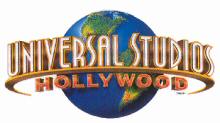
Special Effects Stages
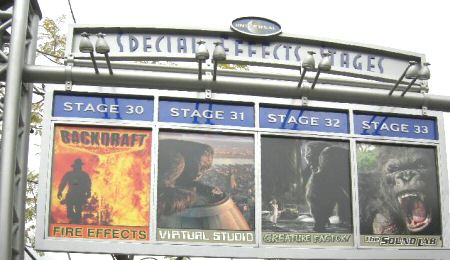
Latest update: Clips from the new King Kong movie have been inserted into the special effects shows. April 2006
Section
1: The Virtual Studio
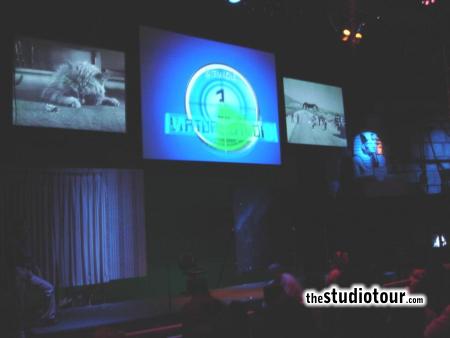
Photo by
MR, January 2006
A
demonstration of camera tricks and compositing
techniques, featuring back projection of a monster
cat outside a window, split screen combining of
a model of a sphinx and a small live-action set,
and a greenscreen re-running of the dinner table
sequence from The Nutty Professor.
INSIDER
KNOWLEDGE
Click on photo to enlarge |
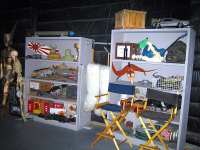 |
Many of
the props that appear on the shelves at the
far left of the first stage are authentic.
The guns are from Waterworld, Skateboard
is from Back to the Future 2, Shrek
maquettes are early character studies from the
film, early Hulk maquette from Universal film
in 1998 that didn't happen, Statue is from The
Mummy, DeLoreon a Back to the Future prop
which appeared in the old version of Special
Effects Stages (see below).
Finally, the gorilla's head is a calling card
that creative director John Murdy leaves in
every attraction he works on. |
|
Section
2: The Creature Shop
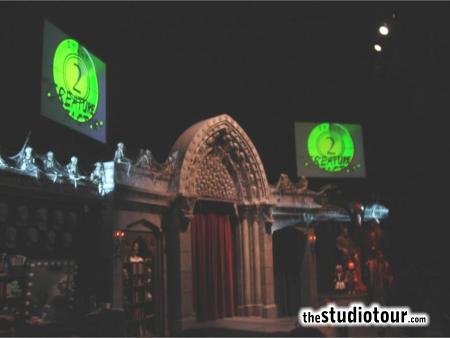
Photo by MR,
January 2006
Showcasing
special effects make-up and robotic and animatronic
creatures with an unforgettable climax featuring
the eight-foot tall robotic "Fluffy".
INSIDER
KNOWLEDGE
Click on photos to enlarge |
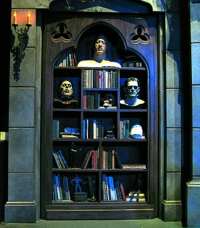 |
Bookshelf
- The bust on the top is a life-cast
of The Rock from Mummy Returns, the Phantom
of the Opera and Frankenstein are on the next
shelf down, and the plaster head on the bookshelf
just below Frankenstein is a cast of creative
director John Murdy from a college play (he
played Penthius who gets beheaded in "The
Bacchae") and the figure on the bottom
right is a wooden monkey, appearing as a cameo
courtesy of the creative director.. |

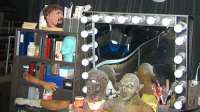
|
Busts from
left to right, life masks are...
Top
Row: Boris Karloff, Tor Johnson, Ice
Cube, Alfred Hitchcock, Michael Burnett (make
up artist who worked on the show) and WC Fields.
Bottom Row: Bela Lugosi,
Roddy McDowell (Planet of the Apes),
Clu Gulager (Return of the Living Dead),
John Williams (character actor from 40's/50's),
David Bowie (The Hunger) and Danny
DeVito.
The green head on the make-up table shelf is
a sculpture by Rick Baker, legendary make-up
artist who designed the make-ups in The
Grinch. |
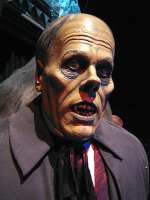 |
Frighteningly life- (or death-)
like model of Lon Chaney as The Phantom
of the Opera. |
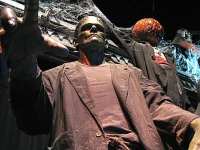 |
Model of Boris Karloff as The
Monster, from Frankenstein. |
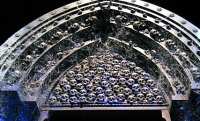 |
Archway of skulls which takes
centre stage. |
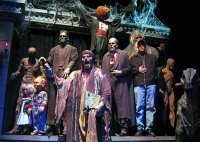 |
Creative Director John Murdy
with the cast of movie monsters. |
|
Section 3: Sound Stage
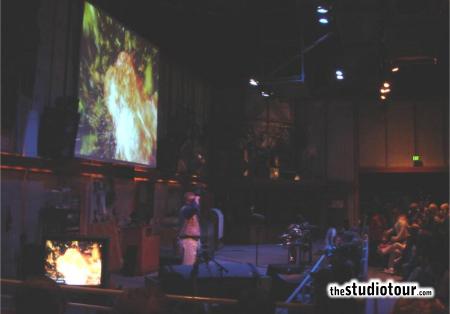
Photo by MR,
January 2006
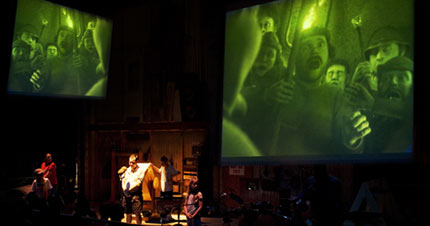
Creating sound effects for Shrek at the Special Effects Stage
Photo © Universal Studios Hollywood
|
What is Foley?
Named after Jack Foley, a foley artist is responsible for all of the
sounds that happen in the film which aren’t spoken. This can
include footsteps, rattling teacups etc. Although very often these
sounds are present whilst the movie is being shot, the sounds picked
up may not be appropriate (for example, an actor walking on a “rocky
island” set mayactually be walking on a polystyrene block in
a studio). The sounds of footsteps on rock are added by the foley
artist. Also, ambient noise in a studio may make any recorded sound
unusable.
What
is ADR?
Automated Dialogue Replacement. This process involves the actor re-voicing dialogue
recorded on set. It was previously known as "looping" because every take was on one "loop" of film, which was replayed and re-recorded over and over until the actor got a perfect delivery of the line, and a perfect match to the timing of the original film. Very often the dialogue recorded
live (known as "wild" sound) is not able
to be used in the final movie, either because of
external influences like an aircraft flying overhead
or a dog barking at the wrong time, or because of
noise from machinery used on set (e.g. wind machines
or other special effects equipment). ADR is a time-consuming
process of repeating the line over and over again
to get an exact match with the visual performance.
Sometimes different actors are brought in to do ADR
work, either due to the unavailability of the big
star, or because the star isn't able to do the performance.
The singing voice of some stars is replaced in musicals,
for example.
Walla What?
Background vocals are often called walla because when the background actor's work is mixed into the film it sounds like "walla, walla, walla" etc. But when recording the actors need to actually make real conversation so the sound mixers have actual dialogue in case they need to raise the level of it in the final soundtrack. The best ADR actors are trained in improvisation because often for walla there is no script. You might have a 1 - 5 minute scene which needs ambient background conversation. It could be a hospital or a police precinct etc. So you need to be able to "talk" your way through any situation.
TIMELINE
There's been a demonstration of the behind the scenes secrets of movie-making from the very early days of the studio tour.
1977? - Six Million Dollar Man Bionic Testing Center 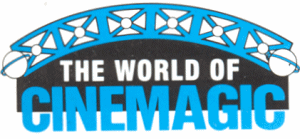
1980? - World of Cinemagic
1983 - Landmark Entertainment started work on the 2010 Special
Effects Stage
1983 - Special Effects Stage updated to include effects used in E.T.
The Extra-Terrestrial.
1984? - 2010 Special Effects Stage opened
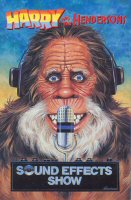 1991 - World of Cinemagic - Stages 30 and 32 are part
of the Lower Lot expansion, where the stages become a stand-alone attraction
rather than being part of the tram tour. One of the stages features
The Magic of Hitchcock, one is The
Back to the Future Special Effects stage housing props
from Back to the Future II, and the other features the Harry
and the Hendersons Sound Effects Show
1991 - World of Cinemagic - Stages 30 and 32 are part
of the Lower Lot expansion, where the stages become a stand-alone attraction
rather than being part of the tram tour. One of the stages features
The Magic of Hitchcock, one is The
Back to the Future Special Effects stage housing props
from Back to the Future II, and the other features the Harry
and the Hendersons Sound Effects Show
July 26 2001 - Back to the Future Special Effects Stage closes
January 2002 - Special Effects Stages opens
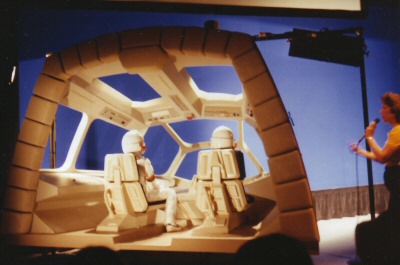
Special Effects bluescreen demonstration in 1981 (photo courtesy Dean Mardon)
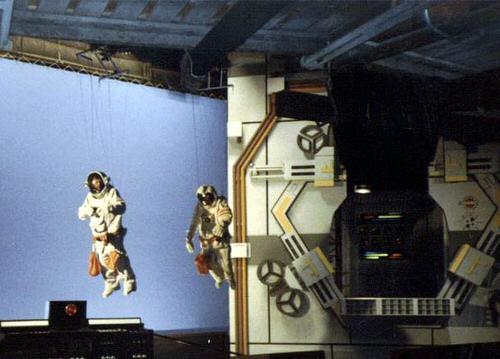
The 2010 Special Effects stage in 1988 (photo courtesy Cathie O'Dea, London UK)
Films featured
in the presentations over the years:
Harry & The Hendersons
The Nutty Professor
Shrek
The Scorpion King
The Mummy
Back to the Future
2010
Psycho
See also The
Six Million Dollar Man & Bionic Woman Testing Center and the World of Cinemagic.
New
'Special Effects Stages' at Universal Studios - 7 January 2002
Universal Studios
Hollywood exposes the entertainment industry’s
greatest movie making illusions in the “Special Effects Stages,” a
new attraction showcasing the sleight-of-sight effects featured in
such Universal blockbusters as “Dr. Seuss’ How The Grinch
Stole Christmas,” “The Mummy Returns,” “Gladiator,” “Jurassic
Park” and the highly anticipated feature, “The Scorpion
King,” starring The Rock, in March 2002.
Designed
to introduce the entire family to the world of Hollywood magic, “Special
Effects Stages” is a half-hour innovative
and interactive attraction configured into three separate stages focusing
on behind-the-scenes filmmaking and cutting edge technology used over
the course of Universal Pictures’ 80-year history.
Within each of
the uniquely themed stages, guests will also enjoy a series of hands-on
demonstrations that literally transports volunteering
audience members from passive observer to actor seamlessly starring
in a variety of Universal’s award-winning films profiled on all
three stages. The attraction will also showcase the secrets behind
some of Hollywood’s greatest effects techniques: make-up, computer
animation, mechanical monsters, as well as practical and sound effects
production.
Located in Stage
1, guests will be introduced to a “virtual
studio” showcasing a series of green screen compositing techniques
and CGI, Computer Generated Imagery, used to bring the “Jurassic
Park” dinosaurs back from extinction, to resurrect “The
Mummy Returns” four thousand-year-old mummy, and recreate the
glory of Ancient Rome for “Gladiator.” Highlights will
also include the use of such practical effects as miniatures and rock
boulders composed of light weight foam.
Stage 2 will
showcase Universal’s historical “creature
factory” introducing guests to the madness behind the creation
of Hollywood’s most notable cinematic monsters, from comical—“Dr.
Seuss’ How the Grinch Stole Christmas!” and “The
Nutty Professor”—to frightening—"The Mummy" and “Chucky”—to
contemporary—“Jurassic Park”—to classic—“Frankenstein” and “The
Phantom of the Opera.”
Guests will be
treated to rare, behind-the-scenes footage of the effects pioneered
by makeup artist Jack Pierce used in “Frankenstein,” Dracula” and “The
Mummy,” and a special behind-the-scenes video montage chronicling
Rick Baker’s award-winning makeup techniques used to transform
Jim Carrey into the Grinch. Highlights will also include a look at
innovative make-up special effects employed to create the cast of Whos
from the town of Whoville.
The attraction
concludes in Stage 3 featuring the art of Foley sound effects production,
a technique pioneered by Universal’s legendary
sound man, Jack Donovan Foley in the 1920s. Sound effects from three
films—“U-571,” “Shrek” and the upcoming “Scorpion
King” starring The Rock—will take center stage as guests
participate and learn about this classic technique through a series
of humorous demonstrations and participate in recreating their own
sound effects tracks.
See Stage 32 page for a list of the productions filmed on this stage before it was used for the Special Effects Demonstration.
Back
to Theme Park Attractions



